Korean Hanbok: Unveiling A History Woven in Silk!
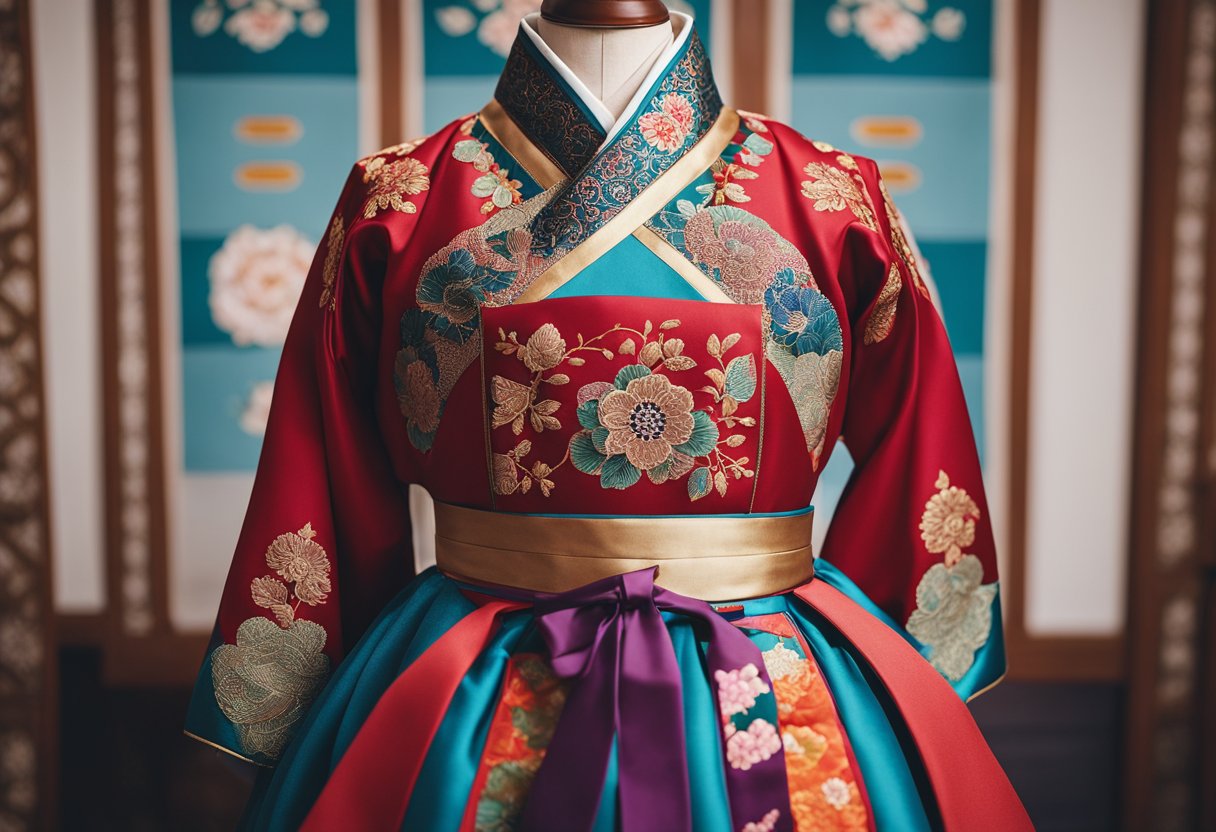
Updated On: March 29, 2024 by Esraa Mahmoud
The Korean Hanbok encapsulates the elegance and artistry of Korea’s sartorial history, telling tales of cultural identity through every thread and fold. Woven prominently in silk, the traditional Korean hanbok has long been heralded for its beauty and significant cultural symbolism. With its origins tracing centuries, hanbok reflects Korea’s historical journey, stretching from the Goguryeo kingdom through the Joseon dynasty and into the contemporary era, where it still holds a respected place in society.
Material evolution played a substantial role in shaping the hanbok, as did social hierarchies and political influences. While earlier hanbok garments favoured simple ramie and hemp, silk’s introduction marked a new era for the hanbok, adding a luxurious sheen and texture coveted by the upper classes. These garments continue to captivate with their vibrant colours and elegant lines, serving as a focal point for designers looking to preserve and innovate.
Origins and History of the Korean Hanbok
In this section, we’ll explore the intricate tapestry of the Korean hanbok’s history, tracing its evolution through various dynasties and the role of silk in its development.
Three Kingdoms Period
The hanbok can trace its beginnings to the Three Kingdoms Period (57 BC – 668 AD), when distinct regional powers established their cultural identities. During this era, the earliest forms of the hanbok began to appear, characterised by the streamlined silhouette that would define the garment throughout Korean history.
Goguryeo Dynasty
In the Goguryeo Dynasty, tomb murals vividly portray the period’s attire. Attributes like a narrow waist and curved sleeves pointed to the aesthetic preferences that informed the design of the hanbok. These garments signalled stature and were often crafted from silk, the fabric indicating a person’s social status.
Silla and Baekje Kingdoms
Silla and Baekje Kingdoms also significantly influenced the development of the hanbok. While sharing commonalities in style, each kingdom imprinted its unique touch on the dress. In Silla, the adaptation of Buddhism cultivated a hanbok that reflected modesty and simplicity. At the same time, Baekje was known for more ornate and elaborate designs in their clothing, nodding to their closer contact with the cultures of China and Japan.
Goryeo Dynasty to Joseon Dynasty Transition
Transitioning from the Goryeo Dynasty to the Joseon Dynasty, the hanbok experienced refinements in form and function. The luxurious silk fabrics of Goryeo gave way to a broader spectrum of materials under Joseon, reflecting both practical needs and changing social norms. Adopting Confucian values during the Joseon Dynasty brought further modifications, pushing towards conservative attire and subdued colours. Despite these shifts, silk remained a beloved fabric, especially for the upper classes’ clothing and special occasions.
Traditional Components of Hanbok
In this section, we’re exploring the traditional components of Hanbok, delving into the integral parts of this historic Korean attire. We’ll focus on the essential elements that give Hanbok its distinctive silhouette and cultural significance.
Jeogori and Chima
The Jeogori is the upper garment of the Hanbok, much like a jacket with long sleeves. It is typically cropped and wraps around the chest, securing at the front. The Chima refers to the traditional skirt worn by women, which is characterised by its voluminous shape. Together, the Jeogori and Chima create a harmonious contrast and are often made from fine materials like silk, adorned with intricate patterns.
Baji and Po
Baji, which translates to trousers, is the lower garment worn predominantly by men, designed with a roomy fit for ease of movement. The Po is a generic term for a robe or outer coat in the Hanbok ensemble, layered over the Jeogori to offer additional warmth and sophistication. The Po often carries symbolic significance, its design and colour signifying the wearer’s social status.
Additional Layers and Accessories
Layers like vests and coats are added for formality and climate adaptability. As for accessories, the Hanbok is complemented with belts, hats, and footwear, each carefully chosen to reflect the wearer’s social class and occasion. The thoughtful selection of these components showcases the depth of Korean cultural traditions and the aesthetic sensibilities of materials and designs inherent to Hanbok.
Symbolism and Cultural Significance
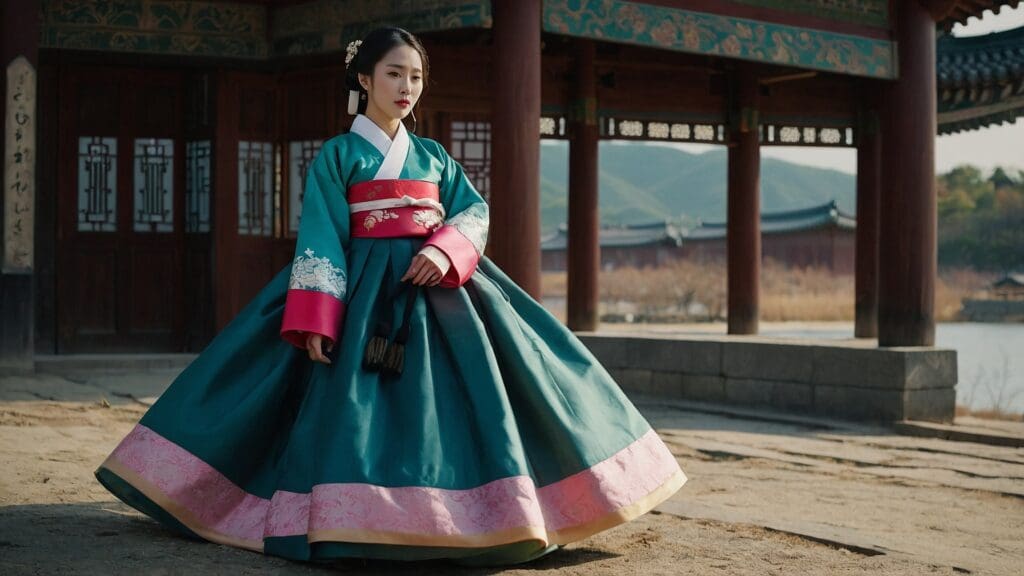
The Hanbok, with its long-standing legacy, embodies deep cultural meanings reflecting Korean culture and heritage. Colours, embroidery, and fabrics are not just for aesthetic appeal; they narrate stories of respect, status, and traditional values entrenched within every fold and seam.
Social Status and Hanbok
Every aspect of the Hanbok is a testament to the wearer’s social positioning. From the ruling royalty to the nobility and commoners, clothing clearly indicates one’s social rank. Royal garments were often made of luxurious silks and vibrant colours, usually augmented with gold and silver threads. In contrast, common folk wore simpler, white Hanbok, reserving colours for special occasions.
Ceremonies and Celebrations
Hanbok plays a pivotal role in Korean ceremonial dress, especially during landmark life events — from the first birthday celebration (Doljanchi) to weddings and funerals. Wedding Hanbok, for example, is usually replete with auspicious symbols. Brides often don Embroidered phoenixes, representing noble love, while grooms don attire bearing the dragon, symbolising strength.
Hanbok in Art and Literature
Hanbok has been immortalised throughout Korean art and literature, encapsulating the nation’s heritage and identity. It appears in countless folk tales, historical texts, and paintings, where it adds an aesthetic dimension and enriches the narrative with cultural context and symbolism. Through these mediums, the Hanbok continues to weave tales of bygone eras, connecting the past with the present.
Material and Textile Evolution
In this section, we explore the transformation of materials and textiles used in traditional Korean dress, showing how the evolution of fabric technology and foreign influences have shaped the hanbok of today.
Silk and Its Precedence in Korea
Silk has been the fabric of choice for hanbok, particularly among the upper classes during the Joseon Dynasty. This luxurious material, derived from the cocoons of silkworms, was valued for its softness and lustre, making it a symbol of status. As a central textile in Korea’s sartorial history, silk’s dominance reflects the country’s taste for refined elegance and its adaptations to social changes.
Introduction of Cotton and Other Fabrics
With the influx of trade and changing social dynamics, cotton and other fabrics, such as ramie and linen, emerged in the Korean textile scene. Lighter and more breathable than silk, these materials became famous because of their suitability for daily wear and greater accessibility to the common people. The adoption of cotton revolutionised clothing for the masses, striking a balance between practicality and comfort.
Modern Materials and Innovations
Recently, the hanbok has seen innovative adaptations, incorporating modern materials that enhance wearability and care. Innovations in textile production have introduced synthetic fabrics that emulate the softness and drape of traditional silk while providing ease of maintenance and durability. These contemporary materials have allowed the hanbok to evolve into a garment fitting for special occasions and everyday use, reflecting tradition and modernity.
Design and Aesthetic Elements
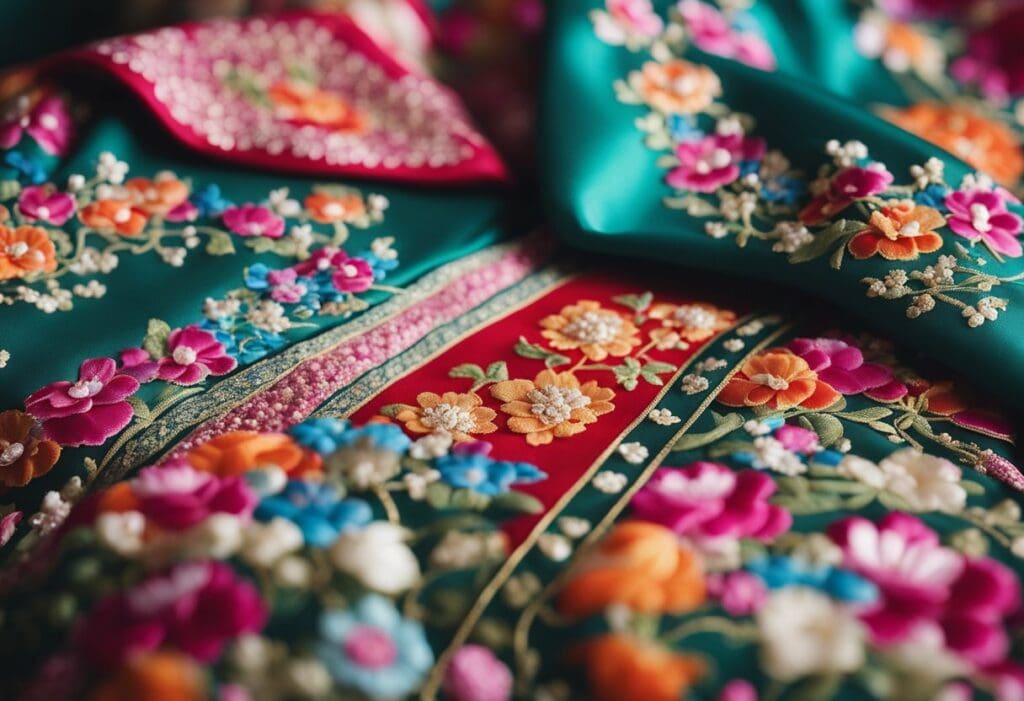
The Hanbok encapsulates a rich cultural narrative, distinguished by its colour symbolism, intricate patterns, and unique structural design. We aim to unveil the key aesthetic elements of this traditional Korean attire.
Colour and Symbolism
Colour in Hanbok is not merely an aspect of design but carries deep symbolic meaning, often reflecting social status, age, and season. Typically, bright and vibrant colours are favoured in children’s Hanbok, exemplifying purity and youthfulness. On the contrary, adults are inclined toward muted tones, embodying dignity and refinement. Celebratory garments showcase primary colours aligned with Confucian values of balance and harmony.
Pattern and Ornamentation
Hanbok is renowned for its elegant patterns and details, often representative of wishes for health, happiness, and long life. Common motifs include nature-inspired elements like bamboo, orchids, and chrysanthemums. Elaborate ornamentation, such as nisae (decorative bands) and git (a band of fabric that edges the collar), adds distinctiveness to the garment, infusing beauty and traditional significance.
Structure and Silhouette
The construction of the Hanbok prioritises grace and modesty, which is evident in its flowing silhouette. A typical Hanbok comprises a jeogori (jacket), baji (trousers), and chima (skirt), crafted to accentuate ease and movement while maintaining an elegant and poised appearance. The silhouette is deliberately roomy and curved, with voluminous skirts and wide sleeves, creating an aesthetic that conveys both simplicity and subtlety in design.
Hanbok on the Global Stage
As aficionados of Korean culture, we have witnessed Hanbok’s traditional attire make its mark on the international scene, largely influenced by the widespread appeal of K-Pop and Korean media.
Influence of K-Pop and Korean Media
Korean Pop, commonly known as K-pop, has been a formidable force in globalising Hanbok. Bands like BTS and Blackpink have integrated traditional elements into their modern wardrobes, presenting a fusion that has struck a chord with international audiences. Their music videos, which often feature Hanbok-inspired outfits, are watched by millions worldwide, serving as a visual feast that bridges traditional Korean culture with the contemporary.
International Fashion and Hanbok
On designer shows and global fashion platforms, Hanbok has found new life through the imagination and reinterpretation of fashion designers. While rooted in traditional aesthetics, these contemporary designs have been tailored to suit the cosmopolitan palate, thus achieving a presence in the international fashion dialogue. This blending of historical significance with modern relevancy is a nod to Korean heritage and a statement on the dynamic, evolving nature of global fashion.
Regional Variations and Influences
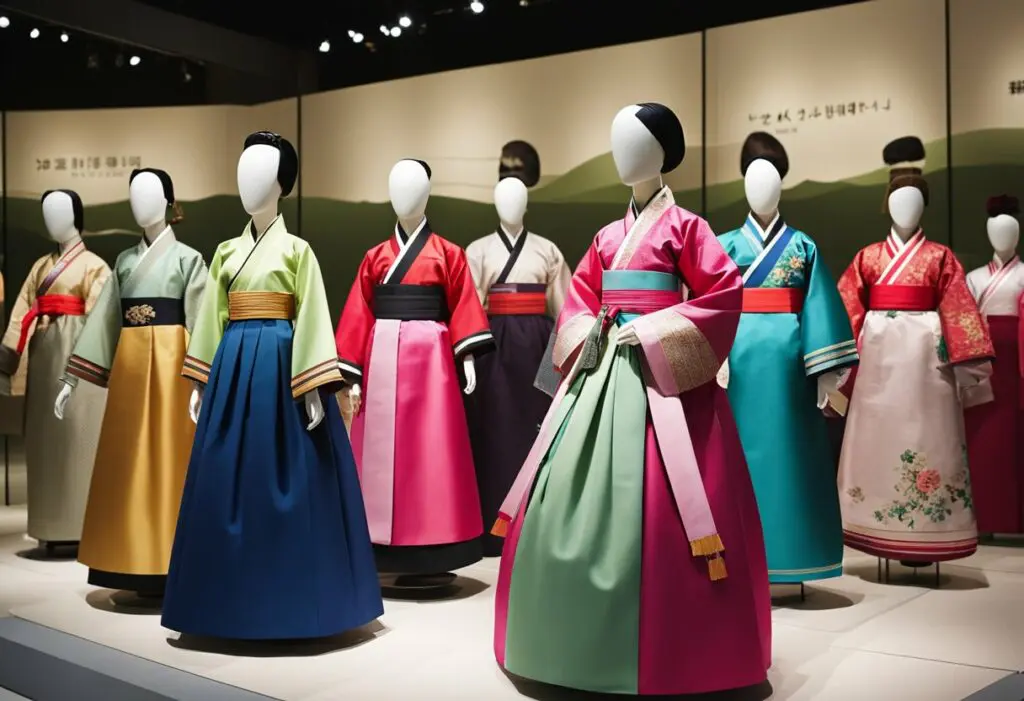
In our exploration of hanbok, we uncover the tapestry of external and regional factors that have shaped its design and cultural significance.
Chinese and Japanese Influences
Hanbok underwent significant evolution during the Tang Dynasty, reflecting the sophistication and styles favoured in China then. The grandeur of Tang attire manifested in the hanbok through vibrant colours and elegant forms. Later, during the Ming Dynasty, the hanbok adopted the straight and uncomplicated lines that were popular in Chinese dress, leading to a more subdued yet still elegant style. Similarly, Japanese interactions brought about subtler changes, as seen in certain accessories and the subtlety of fabric patterns used in hanbok.
North and South Korea Divergence
The political split between North Korea and South Korea has also been echoed in the hanbok’s stylistic variations. In the North, hanbok remains relatively traditional, adhering closely to the designs more commonly seen before the division. In contrast, the South has witnessed a bold innovation in design, allowing contemporary fashion trends to harmonise with this historical garment. The result is a beautiful array of hanboks, from the very traditional to those infused with modern touches.
Diaspora Interpretations
Across the diaspora, the hanbok embodies a blend of heritage and adaptation. Koreans living abroad have played with design elements, integrating aspects of their new cultures with the traditional hanbok silhouette. This has given rise to a diverse collection of hanbok-inspired garments, often maintaining the garment’s essence while showcasing a unique, cross-cultural aesthetic.
These regional narratives show that the hanbok is more than just a traditional Korean dress – it’s a living canvas of history and identity, continuously woven with the threads of its wearers’ experiences.
Contemporary Adaptations and Fashion
In our journey through Hanbok history, we discover a seamless blend of tradition with modernity. The Hanbok has endured through the ages and embraced contemporary fashion, reflecting our ever-evolving cultural identity.
Modern Hanbok Movements
Modern Hanbok movements cultivate a renewed appreciation for traditional Korean attire within today’s cultural landscape. Pioneers lead the charge, delicately incorporating modern sensibilities into age-old aesthetics. This harmonious fusion reacquaints younger generations with the Hanbok’s elegance while keeping the garment practical for everyday wear. The momentum gathered by these movements breathes new life into the Hanbok.
Fusion with Western-Style Clothing
Fusing Hanbok with Western-style clothing is a testament to our innovation and flexibility. The result is a sartorial expression that marries the fluid silhouettes of Korean tradition with the sharp tailoring of the West. This has led to the creation of pieces that are truly reflective of a globalized society, displaying a melding of cultures that is both respectful and forward-thinking.
Hanbok-Inspired Fashion Design
Fashion designers draw inspiration from the rich tapestry of the Hanbok, propelling it onto international catwalks. These designers often maintain the integrity of the Hanbok’s original form while introducing contemporary materials and motifs. The result is a collection of high-fashion garments celebrating the past while pushing modern style boundaries. These creations resonate with those who seek a “Korean in Me” identity, bridging heritage with personal expression.
Hanbok in Ceremonial and Formal Contexts
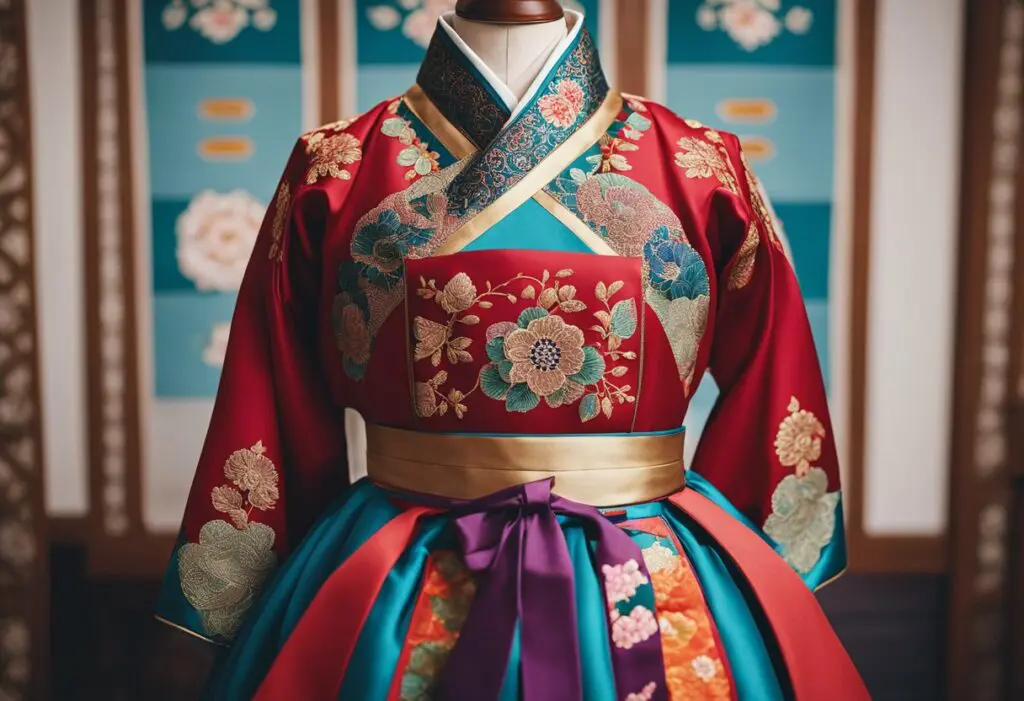
Hanbok, Korea’s traditional attire, remains deeply embedded in our nation’s culture and is often worn during celebrations, ceremonies, and formal events. It holds particular reverence and usage across the Korean Peninsula and extends its influence beyond borders.
Weddings and Celebration Attire
Hanboks for weddings and festivities exhibit vibrant colours and intricate details, symbolising joy and good fortune. Brides historically wear a jeogori (jacket) with a full, wrap-around skirt called a chima, while grooms don a jeogori, baji (trousers), and often a formal robe known as a durumagi. Embroidery on these garments may include symbols such as peonies for wealth and honour or ducks symbolising matrimonial harmony.
Royal and Official Ceremonies
The hanbok worn by the royal family during official ceremonies and court events was designed to display elegance and authority. Fabrics like silk were often used, adorned with patterns representing the wearer’s status. Colours, too, were indicative of rank and occasion, as depicted in numerous historical records and artefacts.
Formal Occasions Beyond Borders
As the Korean diaspora and global interest in Korea’s culture have grown, hanbok has appeared at formal occasions worldwide. Today, we see hanbok embraced during cultural exchange programs, international festivals, and events promoting global cultural diversity, often highlighting Korea’s heritage and the importance of preserving traditional costumes in a rapidly modernising world.
Preservation and Education
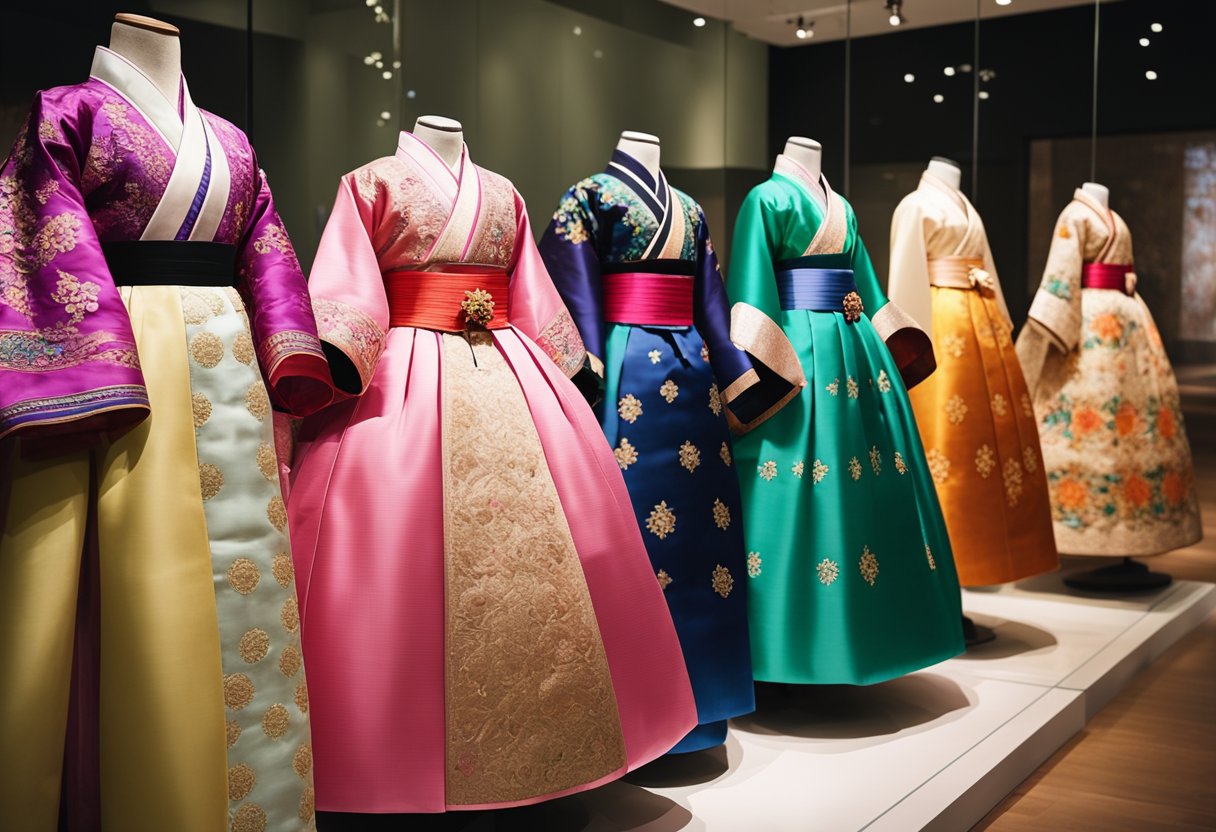
In our endeavour to honour and perpetuate the legacy of the hanbok, we recognise the pivotal roles of museums, educational institutions, and community festivals. They collectively ensure the traditional Korean garment’s heritage continues to inspire pride and unity among the Korean people.
Museums and Cultural Exhibits
Museums serve as custodians of the hanbok, showcasing its evolution and cultural significance. Curating exhibitions illuminate the hanbok’s heritage, allowing visitors to appreciate the intricate details and historical context. For example, the Victoria and Albert Museum offers insights into the traditional Korean dress, demonstrating how it distinguishes itself from Western clothing.
Education in Schools and Workshops
Education is fundamental in preserving the knowledge of traditional crafts. In schools, studying hanbok can foster a sense of pride and unity. Workshops offer practical experience, where the creation and significance of the hanbok are imparted to younger generations, ensuring that the skills and appreciation are passed on.
Community and Cultural Festivals
Cultural festivals provide a vibrant platform for the hanbok to be celebrated and worn by the community. These events remind us of our shared heritage and encourage Koreans to take pride in their national identity. By wearing hanboks during festivals, participants strengthen the bond within their communities, furthering a sense of unity.
Frequently Asked Questions
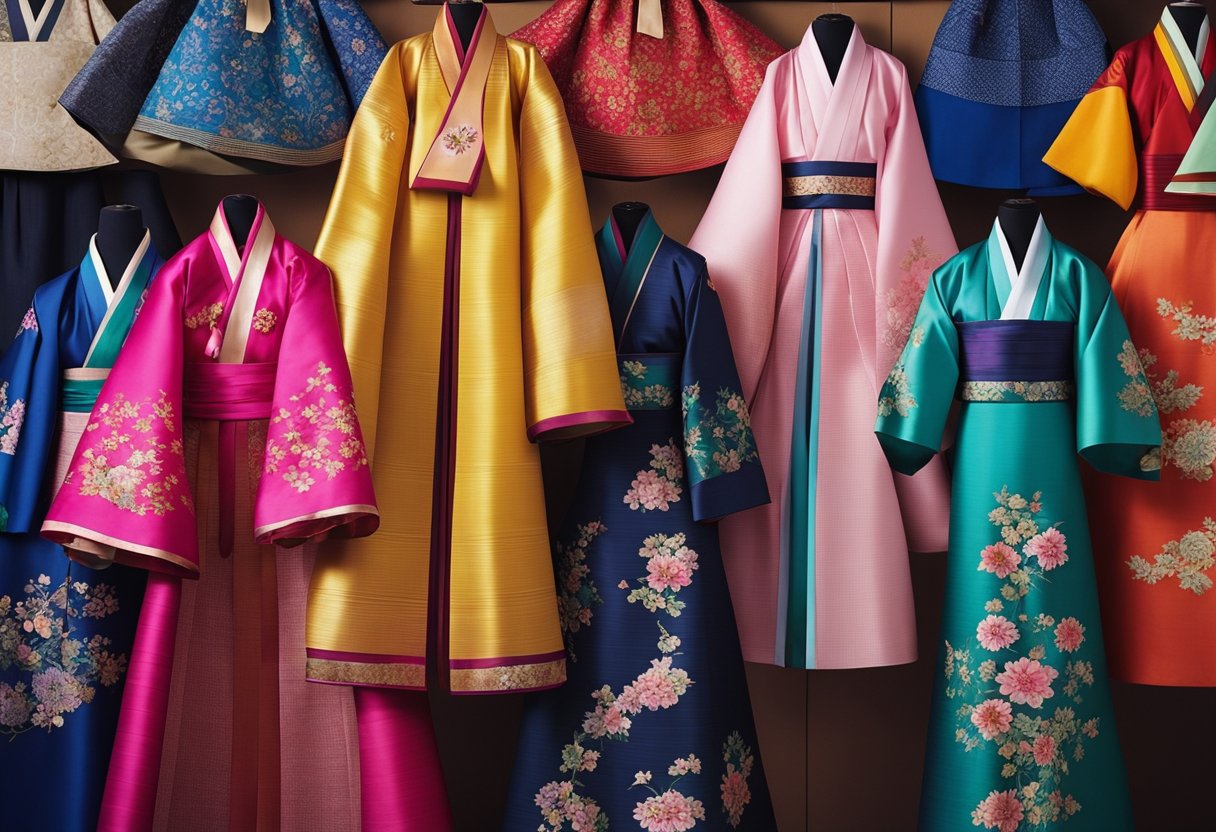
In this section, we address some of the most common inquiries about the traditional Korean attire, hanbok, highlighting its materials, design evolution, distinguishing features, historical significance, cultural importance, and its place in modern fashion.
What materials are traditionally used in the creation of hanbok?
Hanboks are made from natural fabrics such as silk, cotton, and sometimes hemp. The choice of material often depends on the season, and the wearer’s social status, with silk favoured for its elegance and breathability.
How has the design of the hanbok evolved throughout Korean history?
Throughout Korean history, the hanbok has undergone various modifications in its design. Changes have been influenced by social, political, and cultural shifts, transitioning from practical everyday wear in past centuries to more ceremonial use in modern times.
What are the distinguishing features of male and female hanbok?
The male hanbok typically consists of a jeogori (jacket) and baji (pants), whereas the female hanbok features a jeogori and a chima (wrap-around skirt). Men’s hanboks are generally more subdued in colour, while women’s hanboks may exhibit vibrant, bright colours.
Can you share some compelling historical facts about hanbok?
Hanbok dates back over 1,600 years, originating in the Goguryeo Dynasty. Over time, it has been a canvas for Korean craftsmanship and aesthetics, reflecting the country’s social changes and Confucian principles of formality and decency.
What cultural significance does the hanbok hold in Korean society?
The hanbok is a symbol of Korean identity and pride. It holds great cultural significance as it is worn during traditional festivals and celebrations, such as the Lunar New Year and Chuseok. Moreover, it embodies the Korean aesthetic and conveys customary respect for ritual and formality in society.
How is hanbok represented in contemporary Korean fashion?
In contemporary fashion, hanbok has seen a resurgence, often as a source of inspiration for modern designers. They incorporate its silhouette and motifs into everyday wear, thus celebrating its historical value while making it accessible to younger generations and a global audience.






